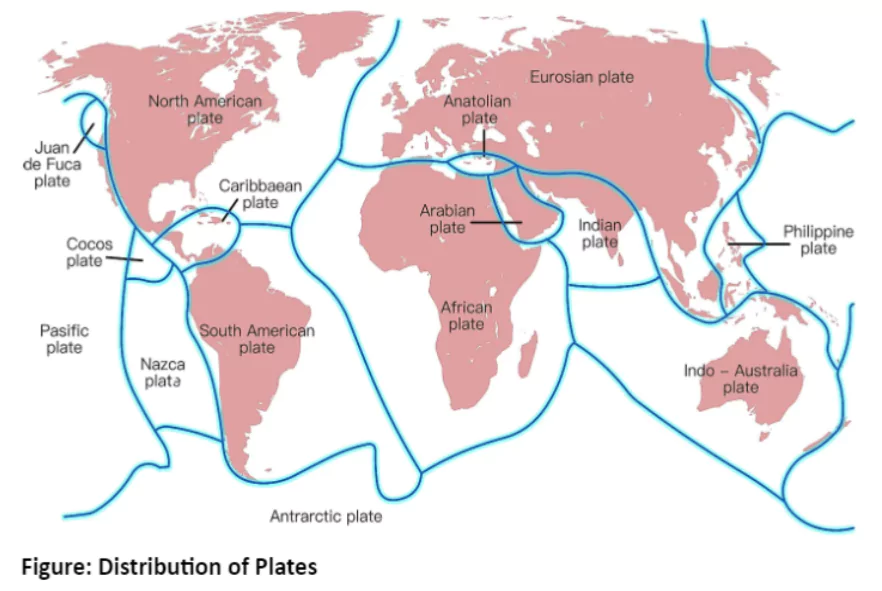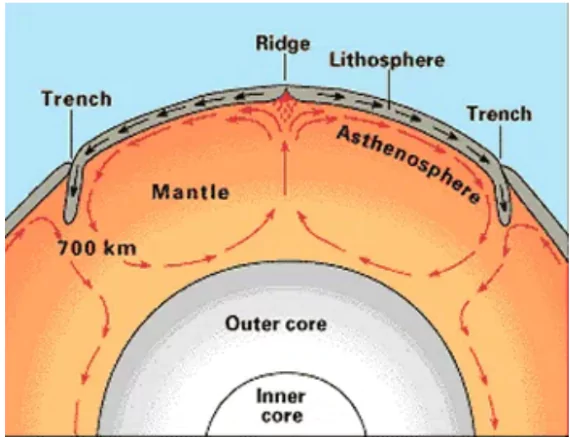Plate tectonics is the scientific theory that explains how the Earth’s outer layer, called the lithosphere, is divided into large pieces called tectonic plates. These plates are like giant puzzle pieces that move slowly over the Earth’s surface. Plate tectonics helps us understand how mountains, earthquakes, volcanoes, and other geological features are formed and how they change over time.
Plate Tectonic: Basics and Importance
- A tectonic or lithospheric plate is a vast slab of solid rock.
- Types of Plates: It comprises both continental and oceanic lithosphere, these plates glide over the asthenosphere as cohesive units.
- A plate’s classification as ‘continental’ or ‘oceanic’ depends on which type of plate dominates it.
- Example: Pacific plate- Oceanic; Eurasian plate- Continental
- Significance: It is the most recent and widely accepted theory that explains:
- Origin of continents and oceans;
- Formation of mountains;
- Occurrence of earthquakes and
- Eruption of volcanoes.
Earth’s Plate Division: Major and Minor Plates

- Movement Driven by Mantle Convection: Lithosphere is believed to be broken into a series of separate plates that move in response to the convection cells in the upper mantle.
- Earth’s lithosphere is partitioned into seven primary plates and several minor ones
- Major Plates: Antarctica and its adjacent oceanic plate; North American plate; South American plate; Pacific plate; India-Australia-New Zealand plate; African plate; Eurasia plate
- Notable Minor Plates:
- Cocos Plate: between Central American and the Pacific Plate;
- Nazca Plate: between South American and the Pacific Plate;
- Arabian Plate: Primarily the Saudi Arabian landmass;
- Philippine Plate: between the Asiatic and Pacific Plate;
- Caroline Plate: between the Philippine and Indian plate (north of New Guinea);
- Fuji Plate: northeast of Australia.
- Plate Convergence: The oceanic plate is heavier than the continental plate. The oceanic plate gets destroyed when there is a convergence zone between the two.
- Similarly, in case of convergence between two ocean plates, the smaller one will get submerged.

Understanding Plate Movement
- Continents are part of tectonic plates, and it’s the plates that move, not the continents themselves.
- Continuous Movement of Tectonic Plates: All tectonic plates have moved throughout Earth’s history and will continue to do so in the future.
- Evolution of Continents: Wegener’s theory of Pangaea suggested all continents were once joined as a supercontinent, but later discoveries show continental masses have been moving independently.
- Formation of Pangaea: It is formed through the convergence of continental masses from different plates.
- Scientists use paleomagnetic data to track the positions of continents in different geological periods.
- Position of the Indian Subcontinent: Particularly Peninsular India, is determined using rock analysis from the Nagpur region.
The Force Behind the Plate Movement

- The Asthenosphere: The slow movement of the hot, softened mantle in the Asthenosphere that lies below the rigid plates is the driving force behind the plate movement.
- Source of Heat: Heat within the earth comes from two main sources: radioactive decay and residual heat.
- Convection Cell: The heated material rises to the surface, spreads, begins to cool, and then sinks back into deeper depths.
- Repetition of this cycle over and over generates a convection cell or convective flow.
- Arthur Holmes first considered this idea in the 1930s, which later influenced Harry Hess’ thinking about seafloor spreading.
Plate Boundaries
- Divergent Boundaries: New crust forms as plates drift apart.
- Example: Mid-Atlantic Ridge- American Plate separates from the Eurasian and African Plates
 Convergent Boundaries: One plate submerges under another at subduction zones.
Convergent Boundaries: One plate submerges under another at subduction zones. - Convergence happens in three ways:
- Oceanic-Oceanic Plate Convergence: Formation of island chain; earthquake and volcano activity.
- Example: Aleutian Islands, Indonesian archipelago, Philippine archipelago
- Ocean-continent Plate Convergence: Subduction of oceanic plate and formation of mountains
- Example: Andes mountains;
- Continental-Continental Plate Convergence: formation of fold mountains; earthquake activity and no volcanic activity
- Example: Himalayas, Alps in Europe, Zagros Mountains in Iran.
- Transform Boundaries: Plates slide horizontally, neither creating nor destroying crust.
- The Rotation of the earth has an effect on the separated blocks of the plate portions.
Enroll now for UPSC Online Course
Isostasy: Balancing Earth’s Lithosphere
- Maintaining Equilibrium: It is the rising or settling of a portion of the Earth’s lithosphere that occurs when weight is removed or added to maintain equilibrium between buoyancy forces that push the lithosphere upward, and gravity forces that pull the lithosphere downward.
- When these two forces balance, the lithosphere is said to be at isostatic equilibrium.
- Significance: Isostasy is responsible for the preservation of high mountains long after tectonic uplift has ceased and for the erosional exhumation of deeply buried rock.
Conclusion
- Plate tectonics explains how the Earth’s surface is always changing. It shows us how huge pieces of the Earth’s plates move around on the layer beneath. These movements cause earthquakes, volcanoes, and the formation of mountains.
- Plate tectonics helps us understand why continents drift apart or collide, shaping our planet over millions of years. It’s the big picture behind many of Earth’s natural wonders and disasters.
![]() April 27, 2024
April 27, 2024
![]() 9920
9920
![]() 0
0


 Convergent Boundaries: One plate submerges under another at subduction zones.
Convergent Boundaries: One plate submerges under another at subduction zones.